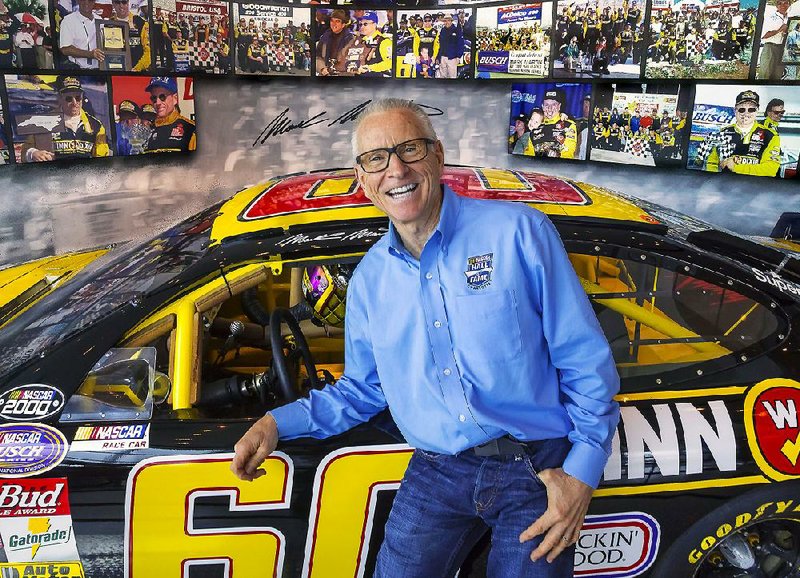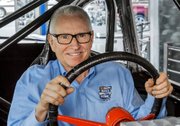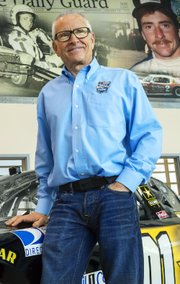BATESVILLE -- The memory roars back into the present, overtaking four decades of auto racing in Mark Martin's mind.
Martin is about 5 years old. He's steering a car down a narrow dirt road somewhere around his hometown of Batesville in the mid-1960s, his tiny hands grasping the large steering wheel. His father is working the accelerator and brake with his feet and propping his son up with his arms.
"Flying," that's how Martin describes their speed.
Up ahead looms a one-lane bridge. Another car, coming from the opposite direction, is bearing down on the tight bridge, too.
"I can't do it," Martin tells his dad.
"Well, then, we'll wreck," comes the reply.
Martin, now 57, recalls the story while sitting in his office at Mark Martin Ford in Batesville. He's wearing Nike eyeglasses and a blue, button-down dress shirt emblazoned with a NASCAR Hall of Fame patch on this mid-August day.
"I presume we went across the bridge," arrives the punchline from Martin, and with this he laughs.
"That was his way of teaching me how to handle things. 'Don't be afraid. Just do it. Because you can. You just don't think you can.'"
What made Martin one of the greatest NASCAR drivers of all time? Perhaps it's the lessons learned on the dirt roads and one-lane bridges growing up around Batesville. There are other parts: intelligence, fearlessness, aggression, grit, technology, drive, fitness, dedication and luck.
Most importantly, he just wanted to win more.
"I didn't drive race cars because it's fun to go around in circles fast," Martin says. "I didn't have any particular joy in going fast in a car. I had joy in breaking a track record, sitting on a pole, winning a race. That's where my joy was."
Win he did. The only NASCAR racers with more victories than Martin's 96 career wins across all three NASCAR series are Dale Earnhardt, Darrell Waltrip, Jeff Gordon, David Pearson, Kyle Busch and Richard Petty, who ended his career with 200 total victories. In the 68-year history of NASCAR, only six drivers have bested Martin's total wins.
So it was probably only surprising to Martin when the call came in May, telling the now-retired Martin that he had been selected to the NASCAR Hall of Fame. He's one of five who will join fellow NASCAR legends such as Earnhardt, Petty, Junior Johnson and Bobby Allison in the sport's shrine in downtown Charlotte, N.C., in January.
Martin didn't show up for the announcement ceremony on May 25 in Charlotte, saying he didn't expect to be voted in. In fact, he says, "I wouldn't have voted myself in."
Instead, his longtime business manager Benny Ertel attended. Martin went on with his life, driving his motor coach to attend his first Indianapolis 500.
Sitting in the audience at the ceremony, Ertel heard the Class of 2017 names as they were read.
Benny Ertel says he looked at his wife, Cheryl, and asked, "They call Mark's name?"
"Yes, they did," she told him.
Ertel immediately called Martin, who was cleaning the bugs off the front of his motor coach when his phone lit up. That's how Martin learned he would become one -- with the Class of 2017's induction -- of 40 people in the hall.
Months later, Martin marvels at his selection, calling it the crown jewel of his career.
"I never won a Daytona 500," he says. "And I never won a NASCAR championship. A lot of people think those are requirements, so what that means to me is, I got myself in there one little tiny piece at a time. I could've had one lucky year and won a championship. Or I could've had a lucky race and won a Daytona 500. But the way I got in there was the hard way. One brick at a time."
TWO WHEELS, THEN FOUR
Martin says the competitive drive is in his genes. His parents -- Julian Martin and Jackie Estes Martin -- were, as Martin describes them, "exceptionally driven people who went and made happen what they wanted to happen." His dad died in 1998, and his mom is now 82.
"They were my heroes. Both of them. My mother is absolutely a superwoman. My dad was ... in my eyes, when you open the encyclopedia and look up the definition of a man, there's a picture of my dad."
Julian Martin owned a trucking company in Batesville, where the younger Martin was born and reared. As a child, Mark worked at the company, washing trucks. He didn't get paid, but he got to drive the clean trucks around the block. That was better than money.
Motorcycles were Mark Martin's first love. He had a minibike at 9 or 10, and graduated to motorcycles at 11. Before all that, he wore out bicycles left and right. His dream was racing motocross.
But his parents stood in his way. They were afraid their son would get hurt. At 13, Martin was already driving. His parents offered a proposition: Give up motorcycles and they'd purchase him any vehicle he wanted.
It was a Chevrolet Blazer.
Martin also had figured out he could "drive fair," he says, so he and his father started working on transforming a 1955 Chevrolet into a dirt-track race car.
"They called themselves 'protecting me' by putting me into a race car instead of racing motorcycles," Martin says of his parents.
Father and son were welding a roll cage into that car one day when Larry Shaw, a Batesville auto repair and body shop owner, passed by. The Martins flagged Shaw down and asked if he could help them tune the car after weekend races.
"As far as I know, I don't know if I ever tuned it," says Shaw, now 70. "We just always worked on it. I didn't know anything about building race cars. They didn't either. No one did."
By spring 1974, that '55 Chevy was ready. On April 12, Martin, who had just turned 15, raced in his first dirt-track race at what is now the Batesville Motor Speedway in Locust Grove. He won his third race and ended the year winning the dirt-track race at Benton Speedbowl, now I-30 Speedway in Little Rock.
He didn't even have a driver's license.
Shaw, who later opened Larry Shaw Race Cars -- builder of 5,120 mostly dirt-track cars since 1979 -- says the teenage Martin "was really determined to win."
"He did not want to settle for second, and he was really dedicated to winning races," he said.
During the next few years, Martin won often on dirt tracks. In 1977, he raced in his first American Speed Association race. He graduated from Batesville High School and won the ASA Rookie of the Year that same year. By 1978, he was a full-time racer, winning his first ASA championship that year and again in 1979 and 1980.
"When I started winning those races, I started thinking I was good enough to be a NASCAR driver," he says. "It was time to evolve."
His first NASCAR race was April 5, 1981, at the North Wilkesboro Speedway in North Carolina. Martin was 22 and "slamming fenders with Richard Petty," who won the race.
Martin finished 27th in that contest and at his next race. By his last race of 1981, though -- and only his fifth NASCAR race that season -- he finished third at Martinsville Speedway in Virginia.
In 1982, Martin competed in all 30 NASCAR races, finishing the season ranked 14th overall.
NASCAR "appeared it would be as easy as all the other things," he says.
It wasn't. Between 1983 and 1987, Martin struggled in NASCAR, bouncing among racing teams. Sponsors were hard to come by. He crashed. Engines gave out.
In 1984 and 1985, he competed in no NASCAR races, instead retreating to ASA, where he won another championship in 1986. Martin raced in five NASCAR races in 1986, but he finished 102nd in the 1987 NASCAR standings, completing only 68 of 400 laps in the Coca-Cola 600, his only race that year.
"I needed that to happen because of the humbling effect that it had on me," he says of his early NASCAR failures. "In order to be extremely successful in that business, I needed to fail.
"I fell to the very bottom and fought my way up."
MR. WIN-IT TO MR. FIX-IT
In 1988, Martin joined Roush Racing on the recommendation of Bobby Allison and competed full time again in NASCAR, finishing three times in the top five.
"That was my break," Martin says of the racing team run by Jack Roush. "I got a second chance. A lot of people don't get the first chance and I got a second chance."
In 1989, he won his first race: the AC Delco 500 at North Carolina Motor Speedway in Rockingham.
He kept winning, with three first-place finishes in 1990. He finished second in the NASCAR Cup Series standings, a feat he would accomplish four more times.
For his career, Martin crossed the finish line first under a checkered flag 40 times in Winston, Nextel or Sprint Cup Series races. It's a NASCAR Cup Series career that includes 271 top five finishes, 453 top 10 finishes and getting 56 poles (the No. 1 starting position) out of 882 races. He has another 49 wins in what is now the NASCAR Xfinity Series and seven more in NASCAR's Camping World Truck Series.
This doesn't mention his five International Race of Champions titles, including consecutive wins in 1996-1998, beating an all-star cast of drivers.
He last raced Nov. 17, 2013, at the Ford EcoBoost 400 at Homestead-Miami Speedway in Florida.
Martin will say his wins -- on dirt tracks, ASA or NASCAR -- were not necessarily about his driving.
"All I knew was if I made my race car better, I would do better on the track," he says. "This should be clear: I never thought about out-driving Dale Earnhardt. I knew I could beat him if I made my car better."
It wasn't a matter of talent, it was a thirst for winning, he says.
"How do you win? You pay more attention than the next guy. You work harder than the next guy. You make your stuff better than the next guy. And you crush them," he adds.
Martin was better than a "pretty dang good race car driver," Ertel says. "Anything he's done in NASCAR -- what's not to be proud of? He's so humble. He could win a race -- I'm telling you win a race -- and be standing in victory lane and I've heard him tell his crew chief, 'Do not bring this car back to the racetrack. Bring a better one.'"
In retirement, Martin has moved back home to Batesville (he lived in Daytona Beach, Fla., during most of his NASCAR racing career) with his wife of 32 years, Arlene. He's even developed some other road hobbies, this time as driver of a motor coach.
He and Arlene toured the West and Southwest earlier this year. When the speed limit in Montana said 80 mph, Martin set the motor coach's cruise control at 80. Martin hasn't gotten a speeding ticket since 1989, in North Carolina, for going 13 miles over the speed limit in what he remembers was a 45 mph zone.
He listens to hip-hop music -- he's a big Gucci Mane fan -- and works around the house. He describes himself as a "Mr. Fix-It right now."
Martin also helps run an automotive dealership empire along with partner Lance Landers. There's Mark Martin Ford in Batesville, started in 2004. There's Mark Martin Kia (next door) and Mark Martin Powersports down the highway.
Then there's Mark Martin Chevrolet in Melbourne and Mark Martin Chevrolet Buick GMC in Ash Flat.
Ertel, 63 and living in Daytona Beach, says retirement has been good for Martin, as the driver once "ate, drank and slept racing."
"Martin never reflected upon his career until he got out of the car. He's cherishing it now. Now, he's getting it. I can't wait for January. I cannot wait until the day he gets inducted into the Hall of Fame."
In the same building as Mark Martin Ford, just south of Batesville on U.S. 167, stands the Mark Martin Museum, filled with trophies, cars, photos, memorabilia and merchandise. But the building is not just a shrine. Rather, it's a testimony to what a small-town Arkansas boy can do.
"I'm extremely proud to be from Arkansas. I'm so happy to be back. I left in January 1979, chasing fortune and fame. Now, I've gathered it all up and brought it back home."
High Profile on 09/11/2016
• DATE AND PLACE OF BIRTH: Jan. 9, 1959, Batesville
• My worst fear is: Failure.
• On weekends you’ll find me: Somewhere near Arlene Martin.
• Guests at my fantasy dinner party would include: Family members who are no longer with us.
• A book I recently read and liked was: Dear Father, Dear Son: Two Lives … Eight Hours by Larry Elder.
• When I was 10 I wanted to: Race motocross. I didn’t know I could race cars at the time. It wasn’t on my radar screen.
• Something few people know about me is: I get my feelings hurt real easy. Most people wouldn’t think that.
• The key to being a good nascar driver is: The ability to harness aggression. The ability to have it but control it. You got to have it. You need it.
• A pet peeve of mine: I really can’t stand when people don’t do what they say they’re going to do.
• My trademark expression: “Wow.” I say that an awful lot.
• I relax by: Sleeping.
• The one thing Iwill not eat: A pickle. They’re gross.
• My favorite music is by: Stevie Nicks/Gucci Mane, depending on the genre.
• One word that sums me up: Driven.


